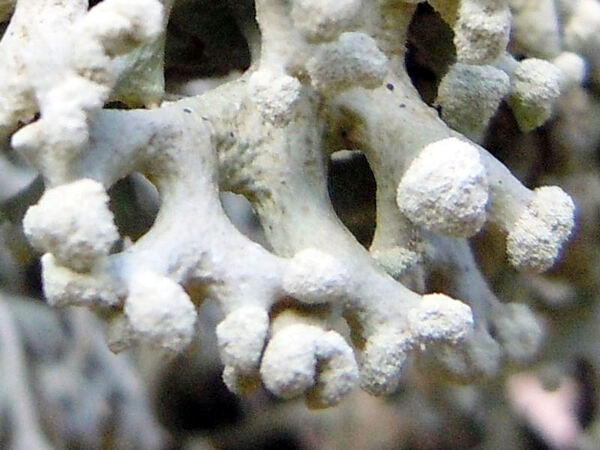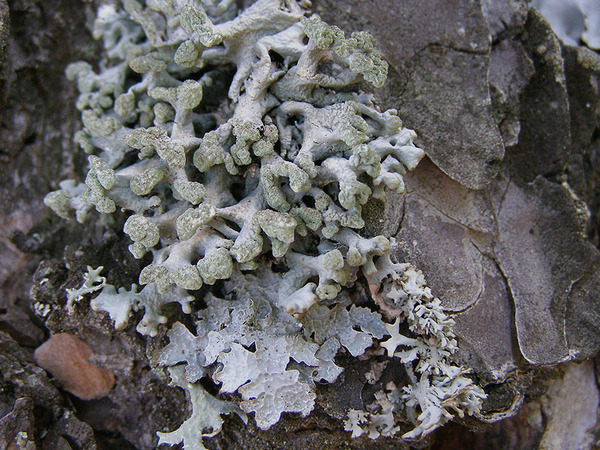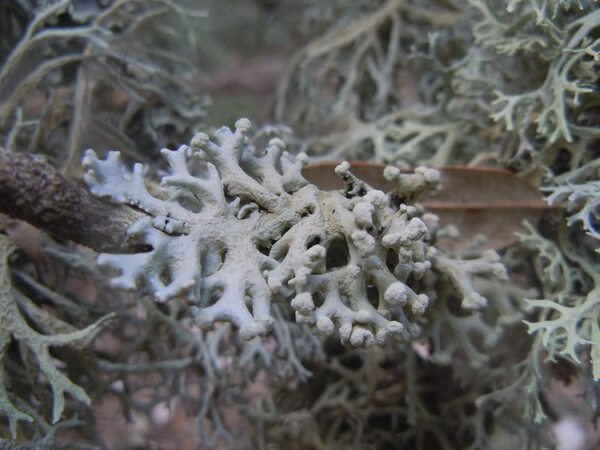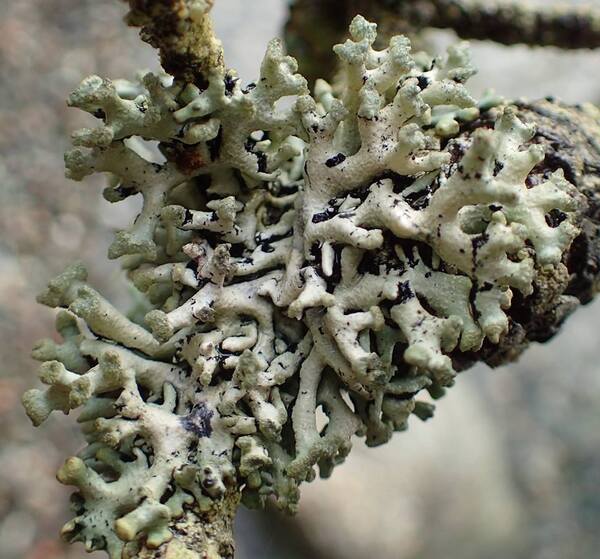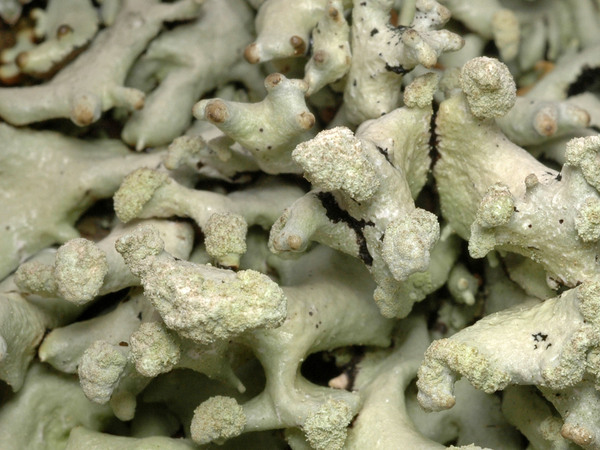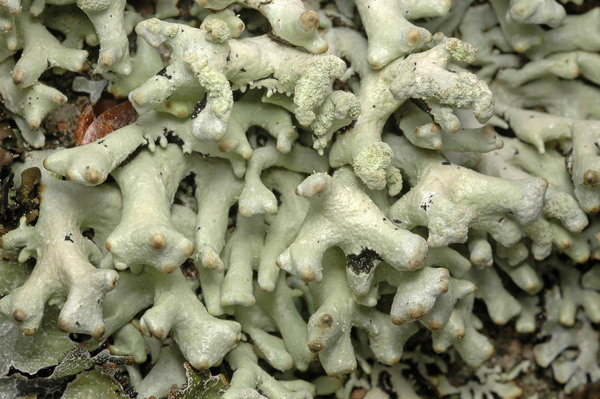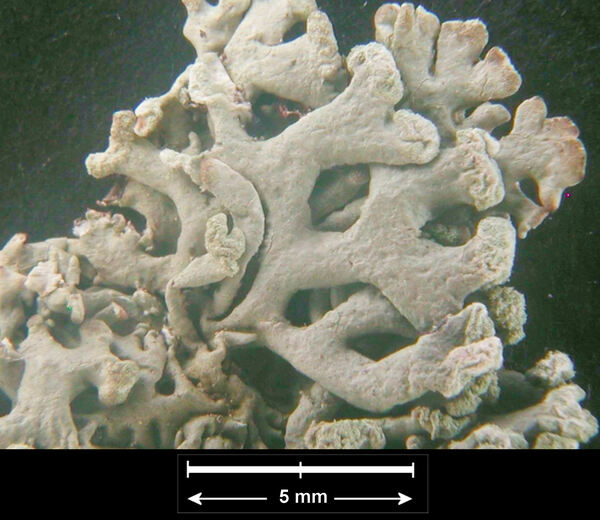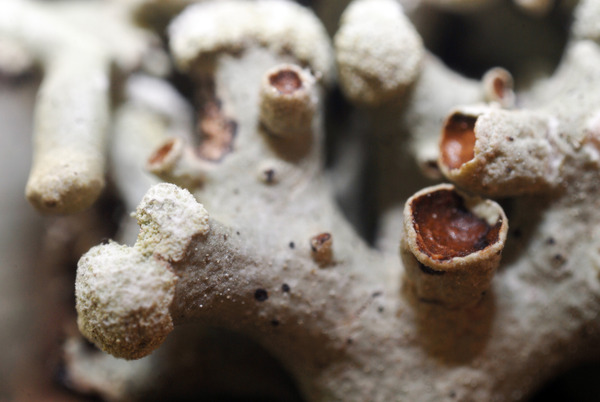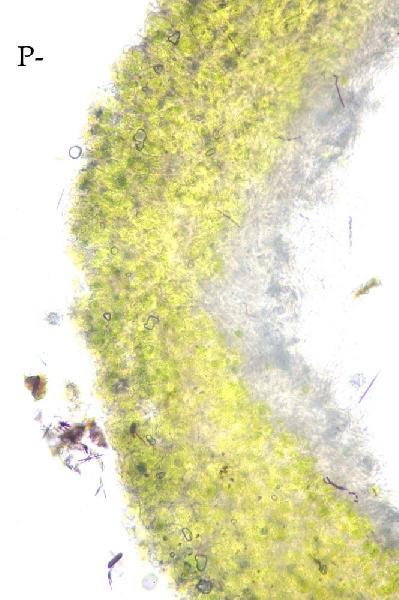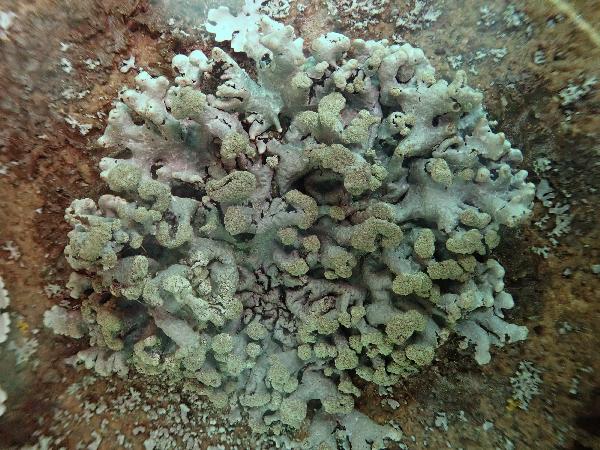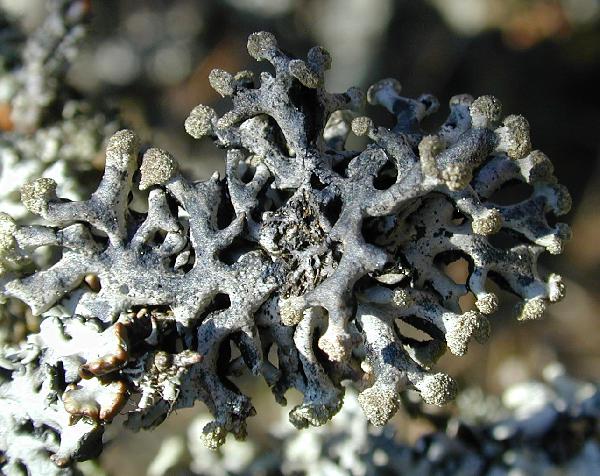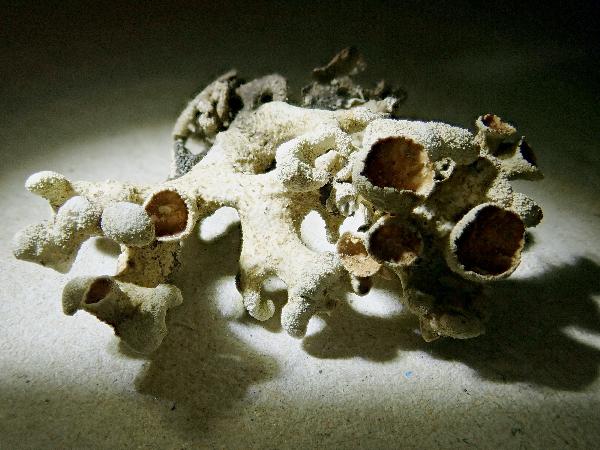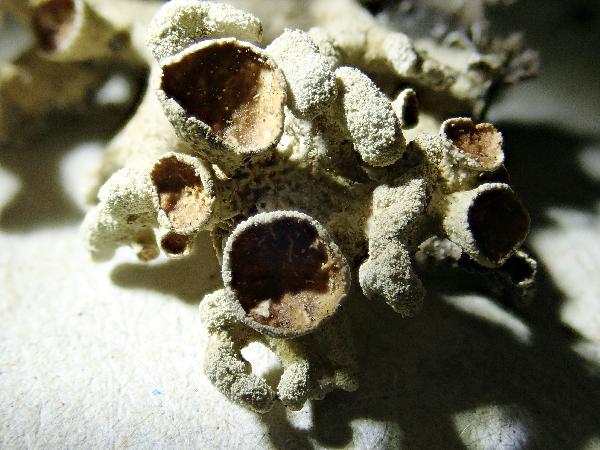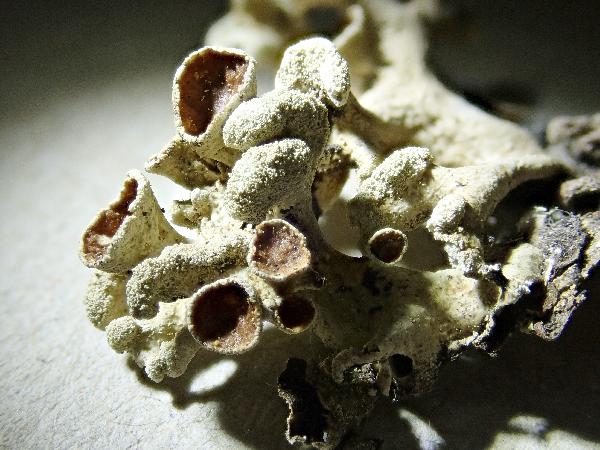Hypogymnia tubulosa (Schaer.) Hav.
Bergens Mus. Årbok, Naturv. raekke, 2: 31, 1918. Basionym: Parmelia ceratophylla var. tubulosa Schaer. - Lich. Helv. Spicil., 10: 459, 1840.
Synonyms: Parmelia tubulosa (Schaer.) Bitter
Description: Thallus foliose to subfruticose, heteromerous, dorsiventral, up to 7 cm wide (usually much less), the lobes subcylindrical, 1-3 mm wide, at first adpressed, then soon ascending, up to 3 mm thick, hollow, mostly convex and smooth, dichotomously branched, grey above, black beneath, the tips bearing capitate soralia with farinose soredia. Lower surface black, wrinkled, erhizinate, attached only in the central or basal parts of thallus, otherwise free. Upper cortex of tightly packed, more or less anticlinally oriented hyphae, the cell walls with Cetraria-type lichenan; medulla soon becoming hollow, lining the cavity inside the lobes, white to dark; lower cortex dark, paraplectenchymatous. Apothecia very rare, shortly stalked, lecanorine, with a red-brown disc and a peristent thalline margin. Epithecium brown; hymenium and hypothecium colourless; paraphyses coherent, simple or sparingly branched in upper part. Asci 8-spored, clavate, Lecanora-type. Ascospores 1-celled, hyaline, subglobose or broadly ellipsoid, 6-8.5 x 4.5-5.5 μm. Photobiont chlorococcoid. Spot tests: upper cortex K+ yellow, C-, KC-, P- or P+ pale yellow; medulla K-, C-, KC+ orange-red, P-, UV- or UV+ pale blue-violet. Chemistry: upper cortex with atranorin and chloroatranorin; medulla with physodic acid (major), 3-hydroxyphysodic acid (major), 2'-O-methylphysodic acid (accessory).
Growth form: Foliose, narrow lobed
Substrata: bark
Photobiont: green algae other than Trentepohlia
Reproductive strategy: mainly asexual, by soredia, or soredia-like structures (e.g. blastidia)
Commonnes-rarity: (info)
Alpine belt: absent
Subalpine belt: very rare
Montane belt: rather common
Dry submediterranean belt: very rare
Humid submediterranean belt: rather rare
Padanian area: extremely rare
pH of the substrata:
1 2 3 4 5
Solar irradiation:
1 2 3 4 5
Aridity:
1 2 3 4 5
Eutrophication:
1 2 3 4 5
Poleotolerance:
0 1 2 3
Altitudinal distribution:
1 2 3 4 5 6
Rarity
absent
extremely rare
very rare
rare
rather rare
rather common
common
very common
extremely common
Loading data...
Occurrence data
Predictive map
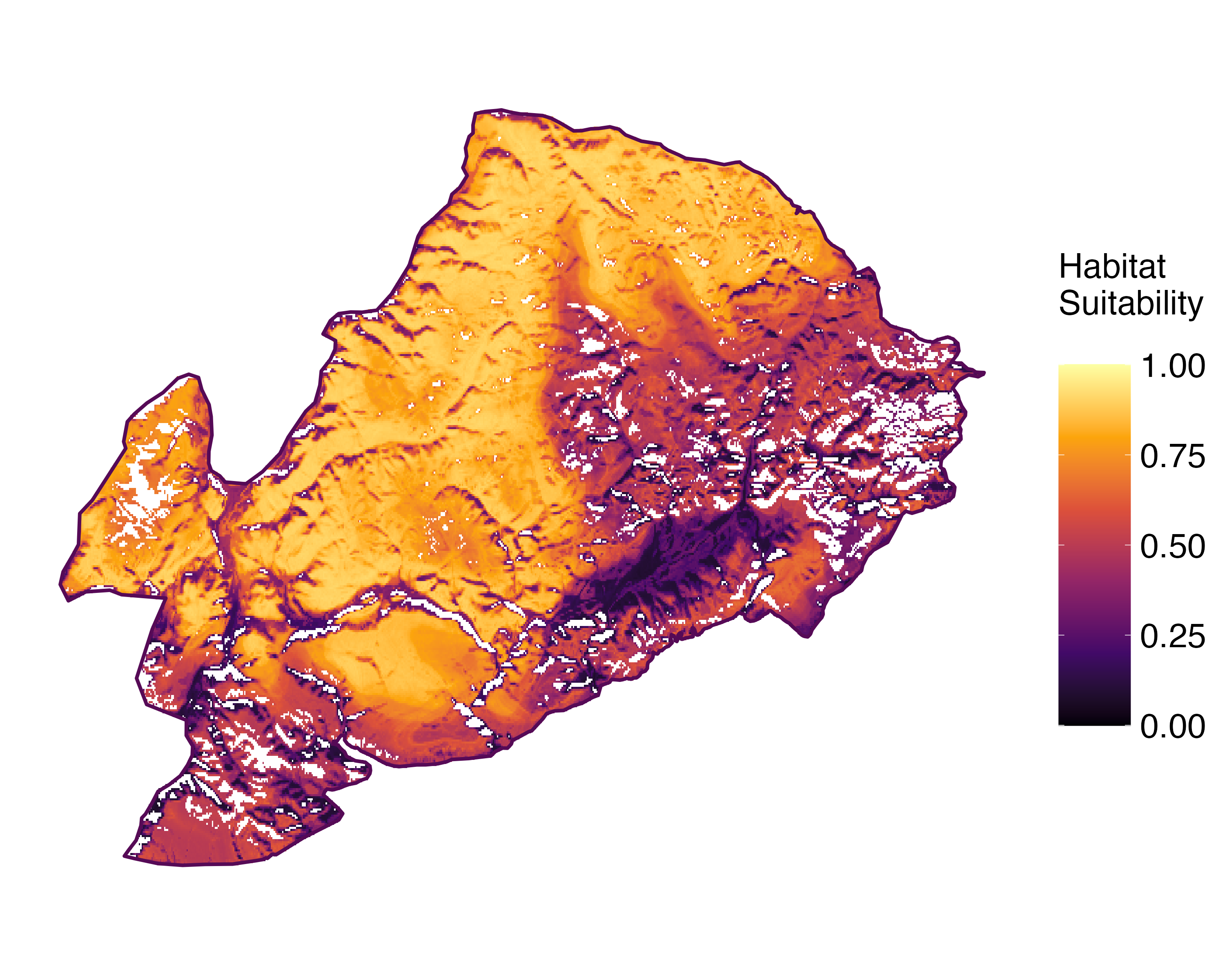 Current prediction (1981-2010)
Current prediction (1981-2010) Future prediction (2071-2100) SSP 1-2.6
Future prediction (2071-2100) SSP 1-2.6 Future prediction (2071-2100) SSP 5-8.5Predictive maps according to Francesconi et al. 2025
Future prediction (2071-2100) SSP 5-8.5Predictive maps according to Francesconi et al. 2025
P.L. Nimis; Owner: Department of Life Sciences, University of Trieste
Herbarium: TSB (13413)
2001/11/23
detail of soralium

Simonetta Peruzzi; Owner: Simonetta Peruzzi
Italy, Toscana, Parco Nazionale delle Foreste Casentinesi
2010
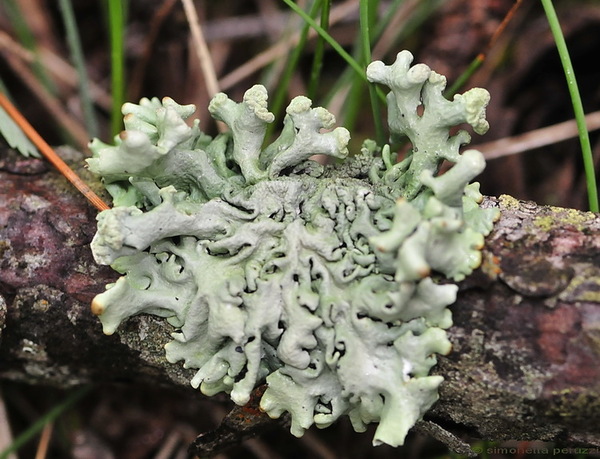
Simonetta Peruzzi; Owner: Simonetta Peruzzi
Italy, Toscana, Parco Nazionale delle Foreste Casentinesi
2010
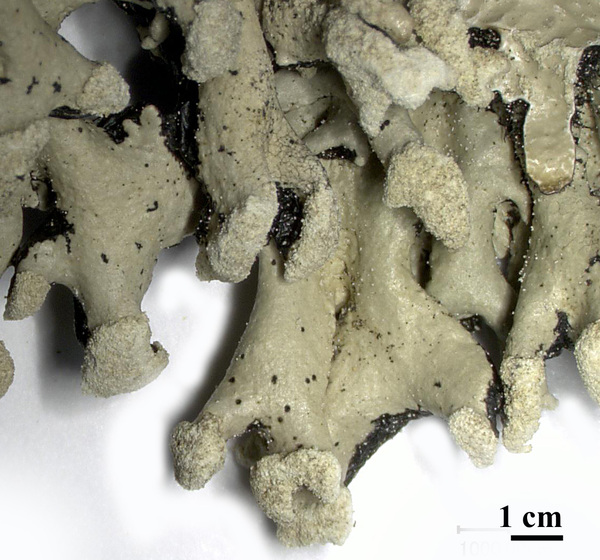
Felix Schumm - CC BY-SA 4.0
[12647], Germany, Baden-Württemberg, Kreis Sigmaringen, 4 km nördlich von Irndorf im Irndorfer Hardt, an Birke. TK 7919. Leg. Schumm 20.09.2006, det Schumm.
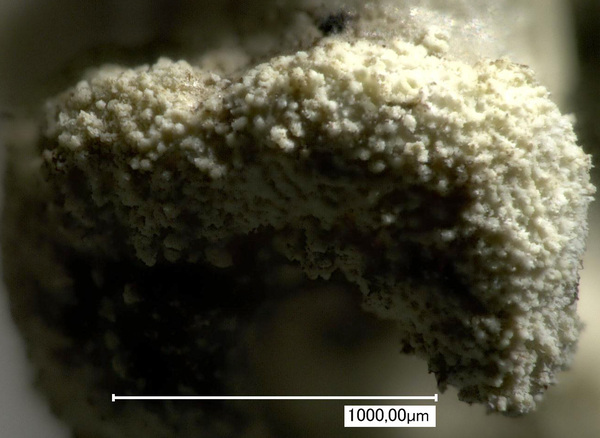
Felix Schumm - CC BY-SA 4.0
[12647], Germany, Baden-Württemberg, Kreis Sigmaringen, 4 km nördlich von Irndorf im Irndorfer Hardt, an Birke. TK 7919. Leg. Schumm 20.09.2006, det Schumm.

Felix Schumm - CC BY-SA 4.0
[12647], Germany, Baden-Württemberg, Kreis Sigmaringen, 4 km nördlich von Irndorf im Irndorfer Hardt, an Birke. TK 7919. Leg. Schumm 20.09.2006, det Schumm.
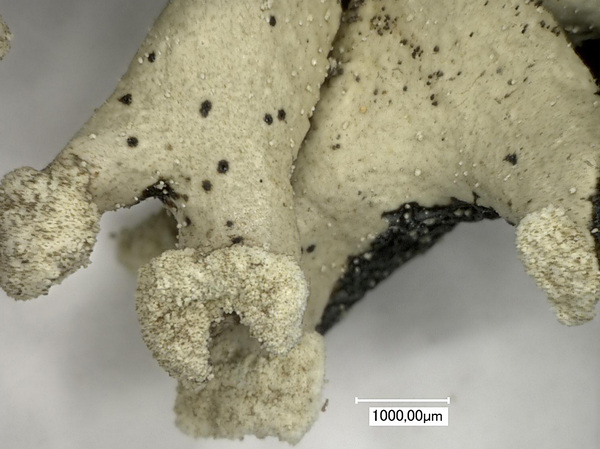
Felix Schumm - CC BY-SA 4.0
[12647], Germany, Baden-Württemberg, Kreis Sigmaringen, 4 km nördlich von Irndorf im Irndorfer Hardt, an Birke. TK 7919. Leg. Schumm 20.09.2006, det Schumm.

Felix Schumm - CC BY-SA 4.0
[12647], Germany, Baden-Württemberg, Kreis Sigmaringen, 4 km nördlich von Irndorf im Irndorfer Hardt, an Birke. TK 7919. Leg. Schumm 20.09.2006, det Schumm.
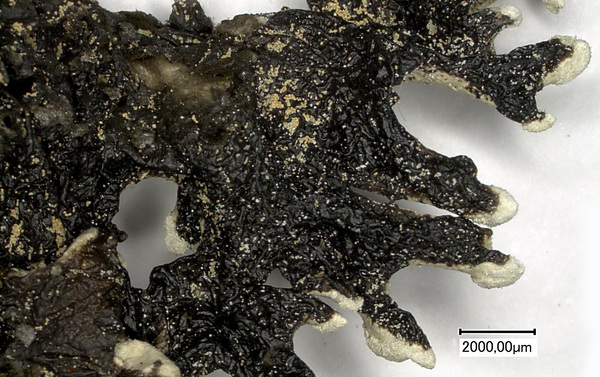
Felix Schumm - CC BY-SA 4.0
[12647], Germany, Baden-Württemberg, Kreis Sigmaringen, 4 km nördlich von Irndorf im Irndorfer Hardt, an Birke. TK 7919. Leg. Schumm 20.09.2006, det Schumm.

Felix Schumm - CC BY-SA 4.0
[12647], Germany, Baden-Württemberg, Kreis Sigmaringen, 4 km nördlich von Irndorf im Irndorfer Hardt, an Birke. TK 7919. Leg. Schumm 20.09.2006, det Schumm.
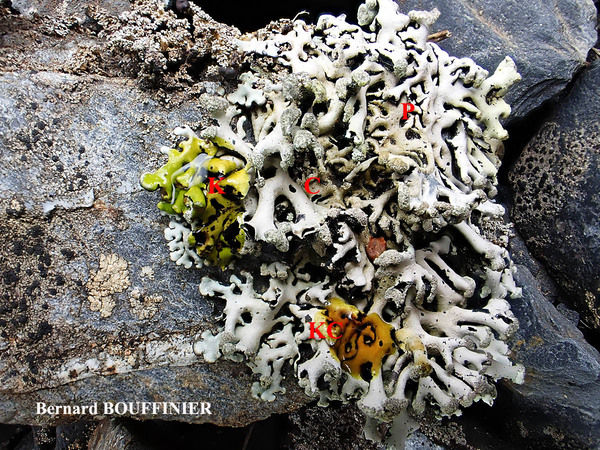
Bernard Bouffinier - Source: http://www.lichensmaritimes.org/index.php?task=fiche&lichen=752&lang=en
France, Commana
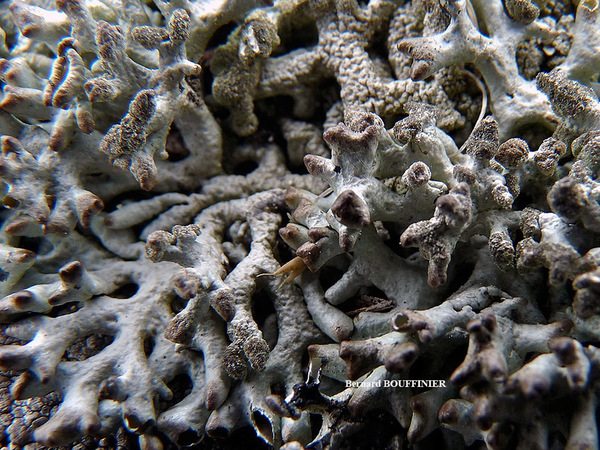
Bernard Bouffinier - Source: http://www.lichensmaritimes.org/index.php?task=fiche&lichen=752&lang=en
France, Pointe du Guern
saxicolous
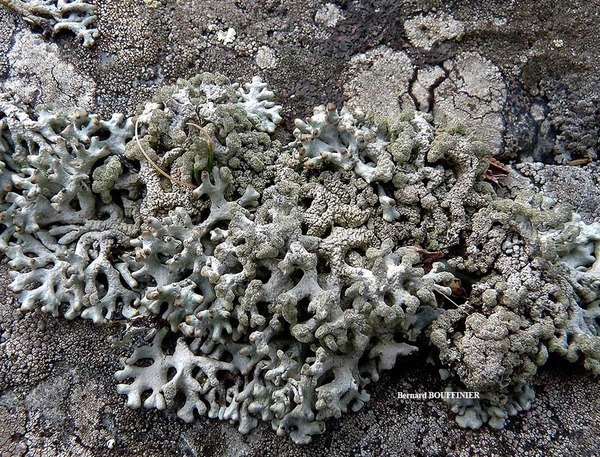
Bernard Bouffinier - Source: http://www.lichensmaritimes.org/index.php?task=fiche&lichen=752&lang=en
France, Pointe du Guern
saxicolous

Bernard Bouffinier - Source: http://www.lichensmaritimes.org/index.php?task=fiche&lichen=1175&lang=en
France, Brennilis
on twigs
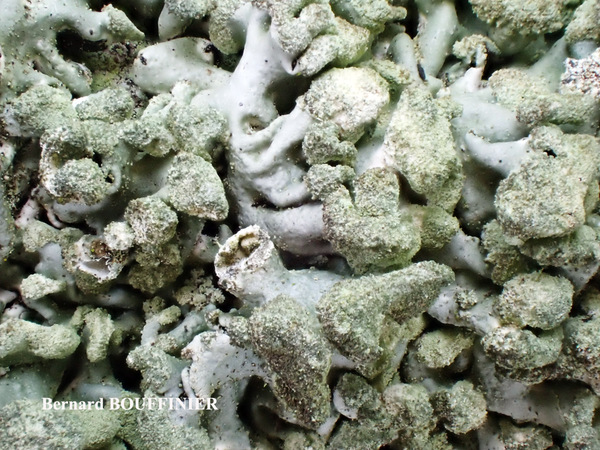
Bernard Bouffinier - Source: http://www.lichensmaritimes.org/index.php?task=fiche&lichen=1175&lang=en
France, Brennilis
on twigs
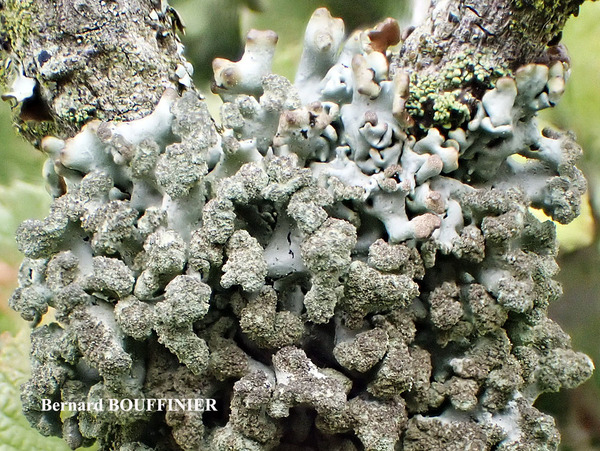
Bernard Bouffinier - Source: http://www.lichensmaritimes.org/index.php?task=fiche&lichen=1175&lang=en
France, Brennilis
on twigs
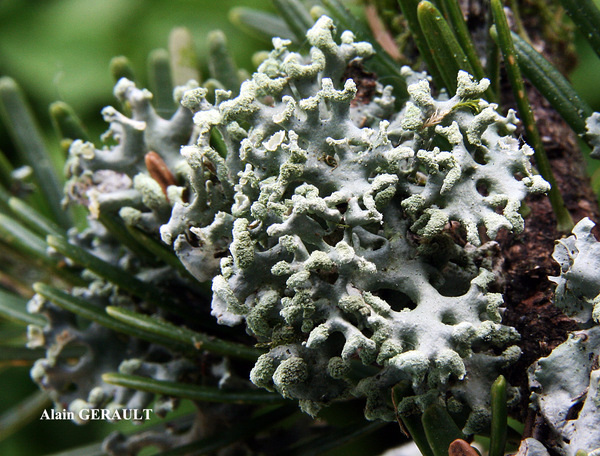
Alain Gerault - Source: http://www.lichensmaritimes.org/index.php?task=fiche&lichen=1175&lang=en
France, Cranou
on twigs
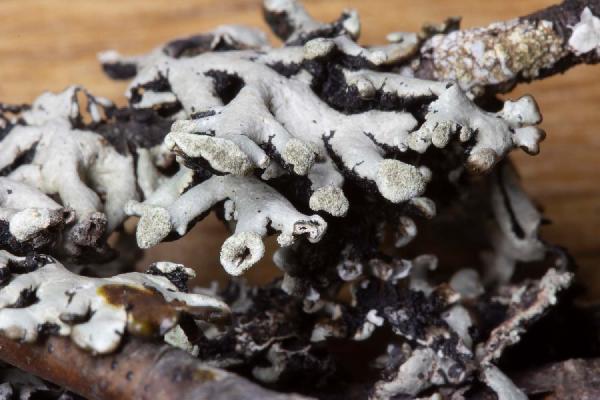
Marta González Garcia - Centro de Estudios Micologicos Asturianos
Spain, Salcedo (Quirós-Asturias), 24-IV-2023, en madera indeterminada.
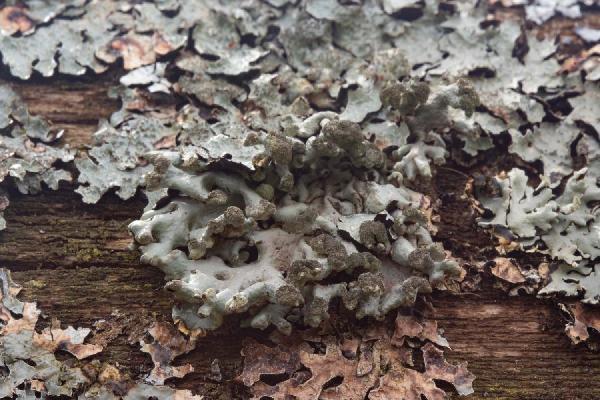
Marta González Garcia - Centro de Estudios Micologicos Asturianos
Spain, Salcedo (Quirós-Asturias), 24-IV-2023, en madera indeterminada.
Growth form: Foliose, narrow lobed
Substrata: bark
Photobiont: green algae other than Trentepohlia
Reproductive strategy: mainly asexual, by soredia, or soredia-like structures (e.g. blastidia)
Commonnes-rarity: (info)
Alpine belt: absent
Subalpine belt: very rare
Montane belt: rather common
Dry submediterranean belt: very rare
Humid submediterranean belt: rather rare
Padanian area: extremely rare
pH of the substrata:
| 1 | 2 | 3 | 4 | 5 |
Solar irradiation:
| 1 | 2 | 3 | 4 | 5 |
Aridity:
| 1 | 2 | 3 | 4 | 5 |
Eutrophication:
| 1 | 2 | 3 | 4 | 5 |
Poleotolerance:
| 0 | 1 | 2 | 3 |
Altitudinal distribution:
| 1 | 2 | 3 | 4 | 5 | 6 |
Rarity
absent
extremely rare
very rare
rare
rather rare
rather common
common
very common
extremely common
Loading data...
Occurrence data
Predictive map
 Current prediction (1981-2010)
Current prediction (1981-2010) Future prediction (2071-2100) SSP 1-2.6
Future prediction (2071-2100) SSP 1-2.6 Future prediction (2071-2100) SSP 5-8.5
Future prediction (2071-2100) SSP 5-8.5Predictive maps according to Francesconi et al. 2025

P.L. Nimis; Owner: Department of Life Sciences, University of Trieste
Herbarium: TSB (13413)
2001/11/23
detail of soralium

Simonetta Peruzzi; Owner: Simonetta Peruzzi
Italy, Toscana, Parco Nazionale delle Foreste Casentinesi
2010

Simonetta Peruzzi; Owner: Simonetta Peruzzi
Italy, Toscana, Parco Nazionale delle Foreste Casentinesi
2010

Felix Schumm - CC BY-SA 4.0
[12647], Germany, Baden-Württemberg, Kreis Sigmaringen, 4 km nördlich von Irndorf im Irndorfer Hardt, an Birke. TK 7919. Leg. Schumm 20.09.2006, det Schumm.

Felix Schumm - CC BY-SA 4.0
[12647], Germany, Baden-Württemberg, Kreis Sigmaringen, 4 km nördlich von Irndorf im Irndorfer Hardt, an Birke. TK 7919. Leg. Schumm 20.09.2006, det Schumm.

Felix Schumm - CC BY-SA 4.0
[12647], Germany, Baden-Württemberg, Kreis Sigmaringen, 4 km nördlich von Irndorf im Irndorfer Hardt, an Birke. TK 7919. Leg. Schumm 20.09.2006, det Schumm.

Felix Schumm - CC BY-SA 4.0
[12647], Germany, Baden-Württemberg, Kreis Sigmaringen, 4 km nördlich von Irndorf im Irndorfer Hardt, an Birke. TK 7919. Leg. Schumm 20.09.2006, det Schumm.

Felix Schumm - CC BY-SA 4.0
[12647], Germany, Baden-Württemberg, Kreis Sigmaringen, 4 km nördlich von Irndorf im Irndorfer Hardt, an Birke. TK 7919. Leg. Schumm 20.09.2006, det Schumm.

Felix Schumm - CC BY-SA 4.0
[12647], Germany, Baden-Württemberg, Kreis Sigmaringen, 4 km nördlich von Irndorf im Irndorfer Hardt, an Birke. TK 7919. Leg. Schumm 20.09.2006, det Schumm.

Felix Schumm - CC BY-SA 4.0
[12647], Germany, Baden-Württemberg, Kreis Sigmaringen, 4 km nördlich von Irndorf im Irndorfer Hardt, an Birke. TK 7919. Leg. Schumm 20.09.2006, det Schumm.

Bernard Bouffinier - Source: http://www.lichensmaritimes.org/index.php?task=fiche&lichen=752&lang=en
France, Commana

Bernard Bouffinier - Source: http://www.lichensmaritimes.org/index.php?task=fiche&lichen=752&lang=en
France, Pointe du Guern
saxicolous

Bernard Bouffinier - Source: http://www.lichensmaritimes.org/index.php?task=fiche&lichen=752&lang=en
France, Pointe du Guern
saxicolous

Bernard Bouffinier - Source: http://www.lichensmaritimes.org/index.php?task=fiche&lichen=1175&lang=en
France, Brennilis
on twigs

Bernard Bouffinier - Source: http://www.lichensmaritimes.org/index.php?task=fiche&lichen=1175&lang=en
France, Brennilis
on twigs

Bernard Bouffinier - Source: http://www.lichensmaritimes.org/index.php?task=fiche&lichen=1175&lang=en
France, Brennilis
on twigs

Alain Gerault - Source: http://www.lichensmaritimes.org/index.php?task=fiche&lichen=1175&lang=en
France, Cranou
on twigs

Marta González Garcia - Centro de Estudios Micologicos Asturianos
Spain, Salcedo (Quirós-Asturias), 24-IV-2023, en madera indeterminada.



